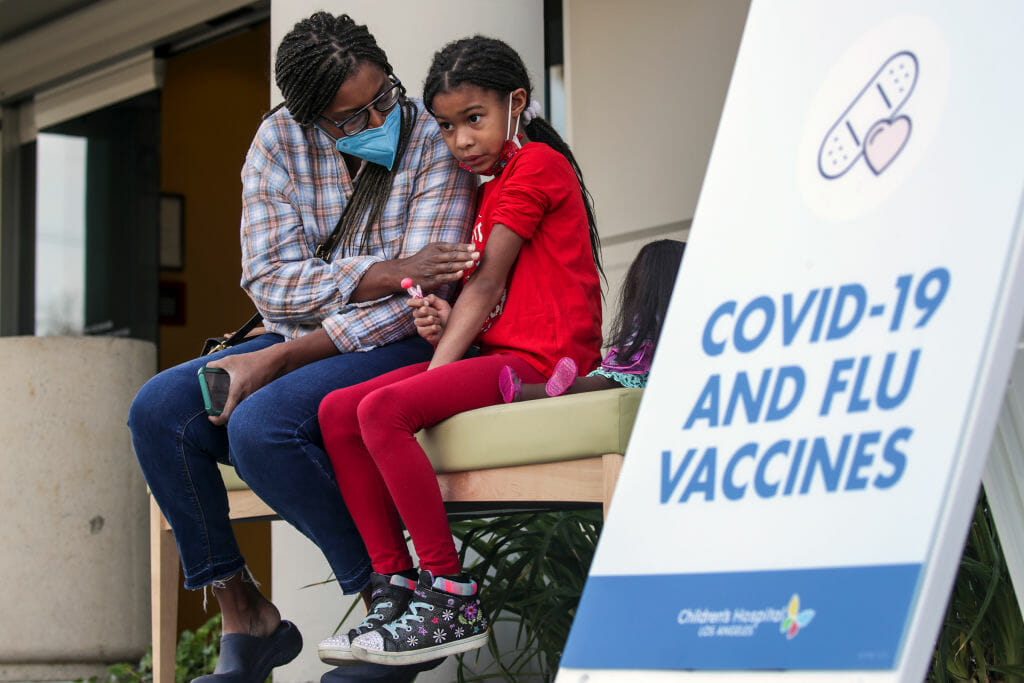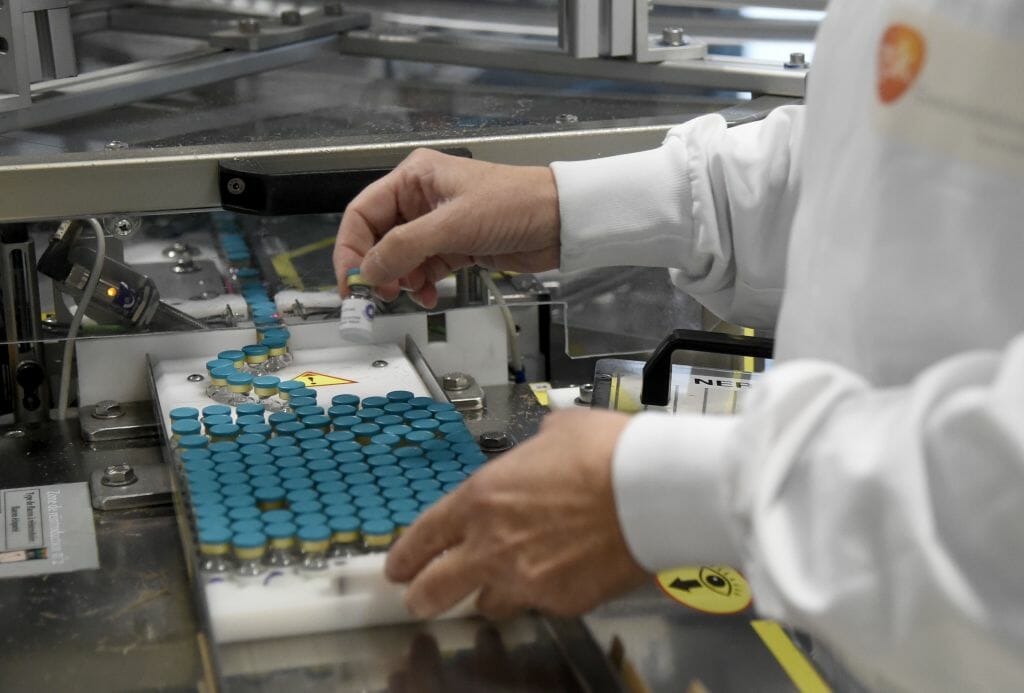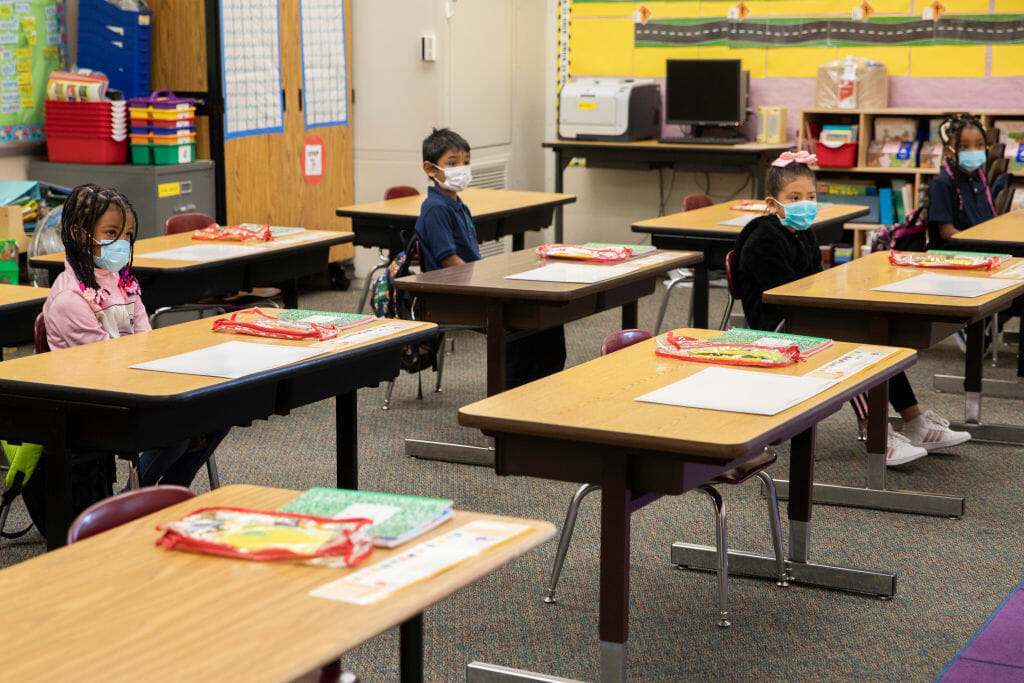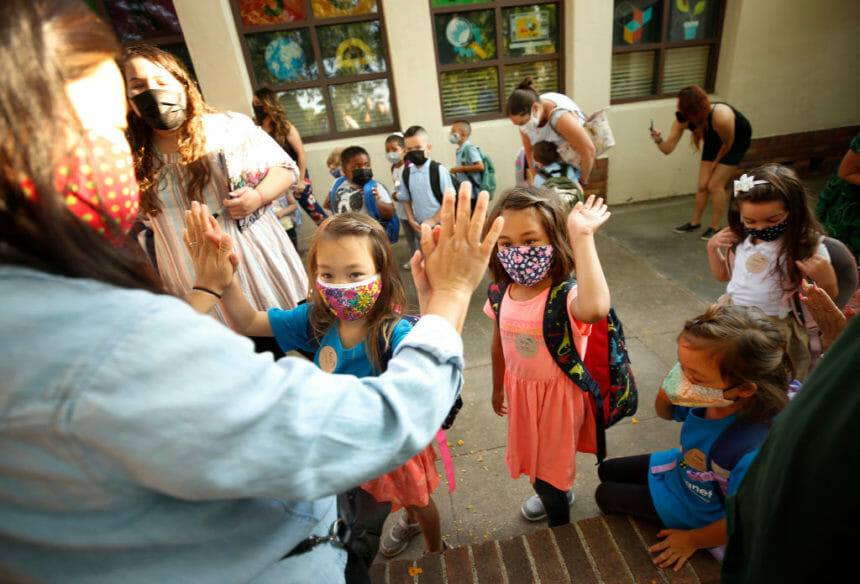The month began not with a groundhog sighting on February 2, but an announcement from Pfizer and BioNTech on February 1.
The companies said they are submitting preliminary data to the Food and Drug Administration – at the FDA’s request – to move ahead with urgency toward a COVID-19 vaccine for children under 5 years of age. The FDA’s vaccine advisory committee will meet next Tuesday to consider the matter.
The under-five set (which doesn’t include Muppets already vaccinated on Sesame Street) will be the final group ushered into the world of COVID-19 immunization. For adults, that era began in December 2020. For adolescents, it started in December 2020 (ages 16-17) and continued in May 2021 (ages 12-15). For kids 5 to 11, it happened last October.
The youngest among us represent the final piece of the puzzle that, fully assembled, will help to maximize protection against a disease that has taken the lives of more than 5.7 million people worldwide and more than 900,000 in this country (including 200,000 in nursing homes, assisted living and group homes, as Danielle Brown reports in McKnight’s Long-Term Care News).
Speaking of puzzles, recent developments pose “a riddle wrapped in a mystery inside an enigma”: Why are vaccination rates for children and adolescents lagging those of adults? (That famous “riddle” quote was Winston Churchill’s description of Russia’s intentions in World War II. Some things don’t change.)
Pediatricians themselves have long made the point that, clinically speaking, children are not simply miniature adults. Vaccination of the youngest will have to move forward on the steam of its own merits and data set.
We must also remember that, for the most part, kids are not their own decision makers – parents, feel free to disagree. Even vaccinated parents have questions and concerns about vaccinating the rest of the household.
Other countries are taking incremental approaches to vaccinating children. In the U.K., vaccination of kids ages 5 to 11 is limited, at least for now, to those considered at highest risk, GP reports.
We explore the evolving world of pediatric COVID-19 vaccination In this pre-Super Bowl newsletter. First, though, here’s a blimp’s-eye view of the full human stadium:
• 251 million people have received at least one COVID-19 shot. That’s 76% of the country’s population and 80% of the vaccine-eligible (age five and up)
• 213 million are fully vaccinated (sans boosters), representing 64% of the population and 68% of the vaccine-eligible.
• 90 million have had a booster, including 45% of fully vaccinated adults. Another 84 million are booster-eligible.
In our weekly countdown, let’s take a closer look at the 72.8 million young’uns under the age of 18, who represent 22.2% of the U.S. population.
10. We’re crawling before we walk
• Nationwide, 30% of children ages 5 to 11 have had their first shot. Just 22% are fully vaccinated. 65% of adolescents ages 12 to 17 have had one shot, while 55% are fully vaccinated.
• The pace of vaccination in young people is slowing. The number of first shots among adolescents dropped from 331,000 per week in mid-January to 106,000 by the end of the month. First shots in kids 5-11 had an initial flurry of activity in November/December but experienced their slowest week yet at the end of January.
• As we so often say to our kids, give it some time. Also needed: equal measures of effort and energy.
• The Centers for Disease Control and Prevention recently recommended boosters for adolescents 12 and older. According to the Kaiser Family Foundation, 21% of parents say their vaccinated adolescent has already had a booster. Another 65% say their child will definitely (41%) or probably (24%) get one.

9. All vaccination, like all politics, is local
Look at a map of the U.S. put together by the American Academy of Pediatrics, and you’ll see first vaccination rates for kids ages 5 to 11 as low as 13% in Mississippi, Alabama and Louisiana and as high as 53% in Rhode Island, 55% in Massachusetts and 63% in Vermont.
Now look at the comparable map for first shots in adolescents 12 to 17, showing a range of 39% (Colorado) to 92% in Hawaii and Massachusetts and 94% in the District of Columbia, with rates of 81% in California, 80% in New York, 67% in Texas and 64% in Florida.
The range underscores the point that impressive numbers can be achieved, a more hopeful harbinger of better days than, say, the groundhog’s shimmering shadow.
8. Little shots for little tots
• The vaccine dose for adults and children 12 and older is 30 micrograms. For kids 5 to 11, it’s 10 micrograms. For the under-5s, it will be 3 micrograms. Mercifully, the needles will be smaller, too.
• The Pfizer/BioNTech COVID-19 vaccine is the only one currently authorized in the U.S. for people under 18.
• Last June, Moderna requested emergency use authorization for its COVID-19 vaccine for adolescents 12 to 17. In October, the FDA told Moderna that it needed more time to evaluate data on the risks of myocarditis in vaccine recipients.
• Moderna is also working on a vaccine for children 6 to 11. The company released top-line data from its Phase 2/3 study last fall, but said it would hold off on formal submission until the FDA completes its review of the adolescent data. Meanwhile, Moderna is seeking approval for ages six to 11 in Canada.
7. Timing is everything
In the aforementioned February 1 announcement, Pfizer Chairman and CEO Albert Bourla said, “Ultimately, we believe that three doses of the vaccine will be needed for children six months through four years of age to achieve high levels of protection against current and potential future variants.” The third dose would likely come eight weeks after the second.
For now, the companies are submitting data on just two doses because that’s what they have in hand and what they need to start a “rolling submission” with the FDA. “If two doses are authorized, parents will have the opportunity to begin a COVID-19 vaccination series for their children while awaiting potential authorization of a third dose,” Bourla added.
Explaining all this, especially to the skeptical, could prove to be every bit as challenging as getting shots in arms. How do you say two birds in the hand are worth three in the bush?

6. This vaccine is rated PG
Parents are the dealmakers and deal breakers when it comes to getting their children vaccinated. Pediatricians, family doctors and other trusted healthcare professionals are the helpful brokers in this decision making process.
As of January, 31% of parents and guardians of children under five say they’ll have their child vaccinated as soon as a vaccine is authorized and available, according to the Kaiser Family Foundation. Another 29% want to wait and see, 12% say they’ll do so only if it’s required and 26% are an emphatic no. Those numbers are more promising than they were last September, when the definite yeses were 23% and the definite nos were 35%.
The definite nos are also dropping in other age groups, from 29% in November to 24% in January among parents of 5- to 11-year-olds and from 30% to 23% among parents of adolescents.
The list of parental concerns, polls show, include short- and long-term side effects, possible impact on fertility and worries about the rapid development of the vaccine. Another hurdle is the perception that COVID-19 poses a negligible risk of serious illness for kids. All the more reason why such decisions should not be made in a vacuum.
5. Trusted. Local. Messengers.
• Several medical organizations have strongly endorsed COVID-19 vaccination of children and adolescents, including the AAP, American Academy of Family Physicians and National Association of Pediatric Nurse Practitioners (NAPNAP).
• The AAP emphasizes that “pediatricians’ role in promoting vaccination among their patient population and in their community is critical.” Pediatricians, the AAP adds, need to answer parents’ questions and help reduce immunization inequities and barriers.
• NAPNAP applauded the arrival of a vaccine for children 5 to 11, saying that “making COVID-19 vaccines available to school-age children is a critical milestone in the pandemic and a strong step forward for public health in the US and safeguarding our nation’s children.”
• As the Ad Council made abundantly clear in launching its COVID-19 vaccination campaign a year ago, trusted local messengers are pivotal to the effort. The Council just released a new survey, “Who Do We Trust With Our Lives?,” which found that the most trusted sources on social issues, including COVID-19, are one’s spouse or partner (72%) and immediate family members (66%). They’re followed by doctors and other medical professionals (60%), close friends (59%) and scientists (51%).
• In Chicago, hundreds of volunteers have been trained as COVID-19 community responders or “vaccine ambassadors,” the Chicago Tribune reports. After months of knocking on doors, they say the key to persuasion is to avoid shame or judgment, encourage conversation and listen well.
4. Can “influenzers” help?
Historically, young children have a better track record of getting their flu shots than adults, a sign that parents recognize the importance of protecting their kids against a potentially life-threatening respiratory virus. Will that sentiment translate to COVID-19? We shall find out.
• In the 2019-2020 flu season, 75% of children six months to four years of age got their flu shot. That figure dipped to 68% in the 2020-2021 season, but was still well above the adult flu vaccination rates of 48% and 50%, respectively, for those two seasons.
• Families Fighting Flu, a national nonprofit founded in 2004, promotes influenza vaccination for the entire family by emphasizing the potential seriousness of the disease and sharing stories of young people who have died.
• Another national advocacy group – Vaccinate Your Family, founded in 1991 as Every Child by Two by Rosalynn Carter and former Arkansas First Lady Betty Bumpers – offers a range of educational initiatives, including the Shot of Prevention blog that provides regular updates on COVID-19 vaccination.

3. Are school vaccine mandates in the future?
The battle over mask mandates in schools is but a mild foretaste of the clashes to come as states consider vaccination mandates for students. The National Academy for State Health Policy reports that 17 states have already taken action to ban COVID-19 vaccination mandates in schools.
California, Louisiana and the District of Columbia have laid the groundwork for K-12 vaccination mandates, tied to something that hasn’t happened yet: Full FDA approval of COVID-19 vaccines for school-age children. Currently, full FDA approval applies only to the Pfizer/BioNTech jab for ages 16 and older and Moderna for 18 and up.
Look for the 2022-2023 school year to become a flashpoint on this issue.
2. Fighting the demons
The effort to vaccinate children is running up against the same types of misinformation and disinformation that have beset the effort to vaccinate adults.
• The CDC, which has taken a beating in the press for its muddled messaging, offers specific guidance on how to address COVID-19 vaccine misinformation. The agency includes tips on how to identify and respond to misinformation through “effective social media listening.”
• Resources such as the Vaccine Education Center at Children’s Hospital of Philadelphia offer a treasure trove of accurate information.
• Misinformation brushfires continue to erupt. In MM+M, Lecia Bushak probes one of the latest: “Is Spotify doing enough to counter health misinformation?”
• Dr. Mark Kline, physician in chief at Children’s Hospital New Orleans, told NBC News, “We’ve spent two years rebutting myths pertaining to COVID… that it’s ‘harmless’ for children. It’s not.”
1. Not a benign disease in children
• The AAP and Children’s Hospital Association, which have been tracking the pandemic’s pediatric pathway, report that cases in children “spiked dramatically” with the Omicron invasion, with nearly 4.2 million cases reported since the beginning of the year and more than 12 million overall.
• The chairs of pediatrics at four medical schools in Florida have written an op-ed for the Miami Herald: “No, COVID is not a benign infection in kids.” They note that pediatric hospitalizations for COVID-19 soared by 52% within one month and that 823 children have died of the disease since the start of the pandemic.
• The doctors cite “emerging evidence that some children, even those with mild symptoms, experience long-haul COVID with long-lasting breathing, heart, brain and cognitive problems,” along with a recently documented heightened risk for diabetes.
• Multisystem inflammatory syndrome in children (MIS-C) is a rare but potentially life-threatening condition associated with COVID-19, causing inflammation of the heart, lungs, kidney, eyes, brain and GI system. There have been 7,142 case reports of MIS-C and 59 deaths, 46% of them in children ages 5 to 11.
• A 10-year-old Texas girl who got sick with COVID-19 before a vaccine was available ended up in the hospital for two weeks with a feeding tube. Her mother told CNBC that while the risk of severe COVID-19 is low in kids, “it’s not zero. It’s absolute misery. It takes its toll on everybody, especially your child. You do not want this.”
Parting shot
On Super Bowl Sunday in SoCal, all who come to SoFi Stadium will receive a KN95 mask. However, anyone five or older won’t get past the gate without proof of COVID-19 vaccination or a recent negative test.
The NFL, in collaboration with the Los Angeles County Department of Public Health, is hosting a COVID-19 vaccination clinic through Saturday. Getting your shot gives you free admission to the Super Bowl Experience, an “interactive football theme park” which otherwise costs $40 per ticket.
…and some songs
Isn’t She Lovely, Stevie Wonder
Take care, be well, many thanks for joining us. Have a super and safe weekend and we’ll see you back here next week as the unmasking of America begins.







